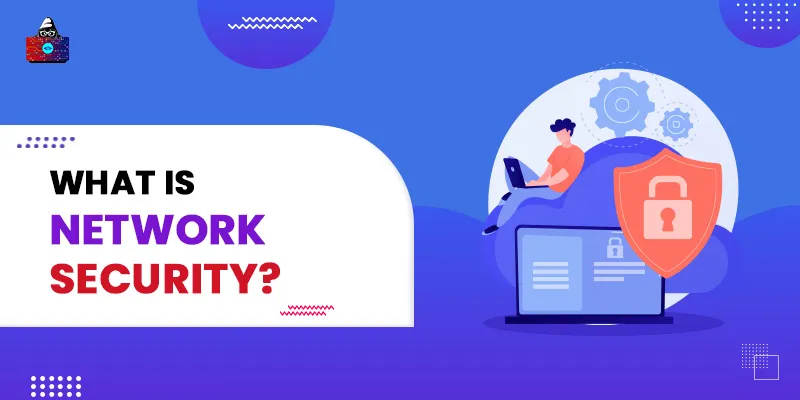With the increase in the reliance of the world on information, there has been a continuous increase in the security risks involved with the same. Therefore, securing information has become essential. There are many facets to protecting digital information, and one of them is network security. It is a set of processes and procedures that aims to secure computer networks.
Any activity that protects the integrity and usability of a computer network and data transferred over it falls under network security. It involves both hardware and software-based technologies and targets many types of threats.
The aim of network security is to stop a threat from entering and spreading on the network. Moreover, it also manages the access to the network, usually by dividing network access into many levels.
What is Network Security?
It is a broad term that includes everything related to securing computer networks. It involves all the practices and processes for detecting, monitoring, and preventing any unauthorized access, denial, misuse, or modification of a computer network or a network-accessible resource.
There are many authority levels in network security, the topmost of which is that of the network administrator. Hence, the network admin controls the authorization of access to data in the network.
To access the information and programs available on the network, the users are assigned an ID and password. In certain cases, there might be additional security measures for logging in for users, such as two-factor authentication and CAPTCHA .
Network admins usually manage an entire team of network security specialists that are responsible for handling different parts of the network. Moreover, network admins and their teams use a wide variety of tools and techniques to ensure the security of one or more computer networks.
The Need for Network Security
Digitalization has completely revolutionized the way we live, learn, and earn. While organizations need to secure their networks to assure complete security of their sensitive information and customer data, individuals require the same for maintaining a high level of privacy as well as staying away from digital frauds and attacks.
The importance of network security is continuously growing with the development of networking technologies. Each day, millions of attacks are launched over networks across the world that involve both individuals and organizations as the targets. Attackers involved in these attacks can be individuals or entire groups.
Hence, we need network security more than ever in the 21st century. Over the years, network security has become sophisticated to better keep up with the evolving methods of network-based attacks and exploits.
Network Security Process
Usually, Itinvolves combining multiple security measures in a layered approach in and around the network. Each layer of network security has some characteristics and policies. While authorized users - depending on their level of authority - are granted access to the network and its resources, unauthorized attempts at accessing the network - and carrying out malicious activities and threats - are barred from the network.
There are network access control tools that help network administrators to distribute access to the network among the users. Usually, network admins divide the network access into many levels and assign them to the users depending on their role in the network. If any user is found to be carrying out any unsafe acts, then warnings are made, followed by strict actions and ultimately removal from the network.
Types of Network Security
It is a broad field. Moreover, with the increase in the volume and complexity of computer networks, the approach to protecting the same has also become extensive. Hence, to ensure maximum network security, it is divided into many types. There are several types in which we can classify. Let’s learn a little about each of them:
- Access Control
Whenever we talk about network security, the first thing that we need to discuss is access control. It’s important to decide the level of access you need to provide to different users depending on requirements. It helps to enforce security policies. Doing so will allow you to provide little to no access to non-compliant endpoint devices and unauthorized users. Thus, it minimizes security risks. Technically, this process is called NAC (Network Access Control).
- Antivirus and Antimalware
Malware is an umbrella term for digital entities - like Trojans, ransomware, and viruses - that can infect systems via networks. In fact, they can lie inactive for many days or even weeks.
Hence, it is important to keep networks free from malware and viruses, and for that, network administrators and cyber security specialists use antivirus and antimalware. This software not only tracks malware and viruses but also destroy them and even repair and fix the damages caused.
- Application Security
There are many applications that you require to successfully run your business. Whether they are homebrew or proprietary, you need to protect them by addressing the security loops and vulnerabilities that they have.
Application security is the act of using hardware, software, and other things to ensure that all your applications stay secure and inaccessible to hackers and cyber attackers. Security professionals leverage many popular application security testing tools to manage application security.
- Behavioral Analytics
Behavioral analytics tools help to distinguish between normal network behavior and abnormal network behavior. These tools flag activities over the network that seem to go awry. Thus, network security teams can better identify points of compromise and resolve them before they can lead to any problems.
- Data Loss Prevention
Every organization has huge amounts of sensitive information that they don’t want to get outside their network. For ensuring the same, DLP or data loss prevention technologies are employed. These help to prevent unsafe forwarding, printing, and uploading of critical information.
- Email Security
Email is probably the most popular means of digital communication. Unfortunately, this also makes it a soft target for malicious users. It is a popular initiating point for phishing attacks. For this, attackers spawn complex campaigns for deceiving users and sending them to sites infected with malware. A type of network security, email security, pertains to blocking spam and dangerous emails and controls outbound emails to prevent the loss of sensitive data.
- Firewalls
A Firewall acts as a barrier between your computer’s network and external networks, like the internet. It uses specific rules to either allow or block traffic between the two networks.
Windows comes with a built-in firewall, known as Windows Firewall. It is a program that allows users to stay away from potentially unsecured networks. Firewalls can be software, hardware, or a mix of the two. Many organizations offer UTM (Unified Threat Management) devices and threat-focused next-gen firewalls.
- Intrusion Prevention Systems
Its methodologies leverage intrusion prevention systems. An IPS continuously scans network traffic to block attacks. For example, Cisco NGIPS (Next-Generation IPS) appliances use cyber threat intelligence to block malicious activities and track suspect files and malware in the network to prevent reinfection and outbreaks.
- Mobile Device Security
Mobile devices have outgrown desktops and PCs in terms of usage. Hence, they have become more susceptible to cyberattacks. Mobile device security is that part of network security that deals with securing mobile devices connected to your network. It controls the mobile devices that can access the network and configure the connections to ensure that network traffic remains private.
- Network Segmentation
In order to make enforcing security policies easier, we use network segmentation. In this, the traffic is divided into different classifications, which are based on endpoint identity and not just IP addresses . Access rights are given to users based on role, location, and other parameters. This helps to provide access to authorized users and block unauthorized access.
- SIEM
Security Information and Event Management (SIEM) tools help network security professionals to identify and react to threats. There are many types of SIEM tools, including hardware and software.
- Virtual Private Network
A simple way to ensure your anonymity over the network is to use a VPN. A virtual private network helps to encrypt a connection from an endpoint to a network. Usually, a remote-access VPN leverages IPsec or SSL to authenticate communication between the device and the network.
- Web Security
The internet is a very dangerous place, especially if you don’t have any security checks in place. This is where web security comes in. Usually, web security involves blocking web-based threats, controlling web use, and restricting access to suspicious websites and links. Taking measures to ensure the safety of a website also comes under web security.
- Wireless Security
Wireless security is a part of network security that deals with securing wireless networks. Compared to wired networks, wireless networks are less secure. Hence, they require stringent security measures. There are several tools and technologies available today that help organizations and individuals secure their wireless networks.
Network Security vs Information Security
Both network security and information security are closely related terms. Thus, they are often compared. Information security, also known as InfoSec, is the practice of securing the distribution and access of information across all platforms and media, and not just digital.
Network security, on the other hand, is only concerned about securing networks and information present over them. While network security mainly focuses on computer networks, information security targets information.
Network Security Testing Tools
Due to the wide variety in network security, there are a galore of tools to help test the different facets of network security. These tools enhance productivity by offering stats and insights that can be converted into profitable actions.
List of Popular Network Security Testing Tools
There are a galore of network security testing tools available for ensuring that organizations maintain the highest level of security for their networks. Check out the following list for the 14 best testing tools for network security:
- Graphite
- Prometheus
- Zabbix
- Nagios Core
- Monitorix
- Icinga
- Observium
- Cacti
- LibreNMS
- Acunetix
- The WAN Killer from SolarWinds
- DataDog
- Wireshark
- Nmap (Navigation Mapper)
Some of these tools offer other forms of testing too. Know more about these tools in detail in our blog post on the best network security testing tools .
Common Features of Network Security Testing Tools
Although there are different testing tools available to check the robustness of a network, many of them share some common features that are the bare minimum for any best network security testing tool. These are:
- Customizable Scheduling
In the context of network testing, scheduling refers to the ability to decide when to collect data and when to not. It is advised to choose network testing tools that have a scheduling agent instead of an on/off switch.
- Filtering
Filtering helps network administrators and network security specialists to narrow down the gathered sampled data. It is important for collecting data from long-running network tests.
- Interactive GUI
Network testing tools come in a variety of user interfaces. This includes command-line, hotkey entry, and GUI. Many testing tools come with an intuitive GUI that reduces learning time and makes it easy to multi-task.
- Network Testing Management
All subsequent network tests take reference from the initial network test. Later tests are compared with the results of the initial test and checked whether there are any changes. A powerful network testing tool comes with an easy-to-use and extensive network testing management system.
- Reports
Usually, a powerful network testing tool is capable of presenting an extensive network testing database in the form of detailed charts, graphs, and tables. Best network security testing tools come with the capability to generate quick, on-time reports.
- Stats
It’s easy to make a better sense of available data in the form of stats. Generally, the more statistics that a network testing tool offers, the better is the tool.
- Testing Templates
Many network security testing tools come with already predefined network testing templates. These templates fast-track the process of network testing and include regular setup, filtering, scheduling, and more.
Conclusion
It is just as important as cybersecurity and information security for organizations that need to maintain their reputation and brand value. It is of utmost importance to save the customer and business-critical data from falling into the hands of people with the wrong intentions. Thus, ensure maximum network security with the best tools and approaches available.
What are your views on network security? Use the comments section below to propagate your take to us.
People are also reading:



![What is TCP/IP Model? [Definition, Working, & Layers]](/media/new_post_images/TCP_IP_Model.webp)
